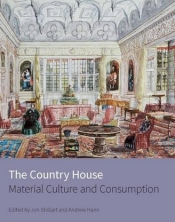The Country House: material culture and consumption
The Country House: material culture and consumption, Jon Stobart and Andrew Hann (eds), Historic England, 2016, 224 pages, 122 colour and black & white illustrations, hardback.
At first sight this looks like a coffee-table book, but the contents far outweigh the glossy exterior. The book records a conference at the University of Northampton in 2012, which was organised in conjunction with English Heritage, and with support from the Economic History Society. As the editors acknowledge, many books have been published on country houses, but this one differs by providing a collection of 19 essays on an area that is often overlooked, namely consumption. The essays are grouped into five collections.
The first five essays cover ‘Elites, consumption and the country house’, looking at the diversity of the ‘new luxury’, who the consumers were, and the demand and supply of these goods. ‘Continuity, heritage and the country house’ considers the show of wealth, and how ‘buying new’ was not always considered a polite thing to do. It explores the reasons why some houses were not modernised, which was not just due to financial reasons, as is often taken as the standard response.
The middle part looks at the influence of trade with the east, with a collection of four essays under the title of ‘Eastern connections, adoptions and imitations’. This discusses not only the nature of imports, but also how such articles had an effect on our architecture, interior design and social behaviour, the most obvious example being that of taking ‘tea’ in the afternoon.
Part Four covers the consumption of food within the country estate, how families settled into the new house, including choosing decorative schemes for new and existing buildings, and how music played a part in the social and cultural lives of the owners and their guests.
The last section examines the presentation of the country house, visitors’ experience and finally, in the context of Coleshill House, the estate that has lost its centrepiece. Here, the author Karen Fielder considers the problems presented to the modern-day visitor with interpretation and understanding of an estate where the house no longer remains.
The essays cover the period from the late 16th century to the Victorian era, each one providing responses to current questions around the culture and identity of the country estate, looking at their use and function, the demand for new luxury goods, how these were displayed for contemporary consumption, and how they might best be displayed to modern-day visitors. The authors, who come from a variety of backgrounds, challenge preconceived ideas about the architecture of the house and its social status.
It is a superb book, not only because of the quality of the illustrations and production, but because it provides new insights on the development of the country estate within the context of an increasingly materialistic nation
This article originally appeared in IHBC’s Context 150, published in July 2017. It was written by Janice Gooch, architectural historian and building surveyor.
--Institute of Historic Building Conservation
Related articles on Designing Buildings
IHBC NewsBlog
Old Sarum fire in listed (& disputed) WW1 Hangar - Wiltshire Council has sought legal advice after fire engulfed a listed First World War hangar that was embroiled in a lengthy planning dispute.
UK Antarctic Heritage Trust launches ‘Virtual Visit’ website area
The Trust calls on people to 'Immerse yourself in our heritage – Making Antarctica Accessible'
Southend Council pledge to force Kursaal owners to maintain building
The Council has pledged to use ‘every tool in the toolbox’ if urgent repairs are not carried out.
HE’s Research Magazine publishes a major study of the heritage of England’s suburbs
The article traces the long evolution of an internal programme to research 200 years of suburban growth
IHBC Context 183 Wellbeing and Heritage published
The issue explores issues at the intersection of heritage and wellbeing.
SAVE celebrates 50 years of campaigning 1975-2025
SAVE Britain’s Heritage has announced events across the country to celebrate bringing new life to remarkable buildings.
IHBC Annual School 2025 - Shrewsbury 12-14 June
Themed Heritage in Context – Value: Plan: Change, join in-person or online.
200th Anniversary Celebration of the Modern Railway Planned
The Stockton & Darlington Railway opened on September 27, 1825.
Competence Framework Launched for Sustainability in the Built Environment
The Construction Industry Council (CIC) and the Edge have jointly published the framework.
Historic England Launches Wellbeing Strategy for Heritage
Whether through visiting, volunteering, learning or creative practice, engaging with heritage can strengthen confidence, resilience, hope and social connections.















